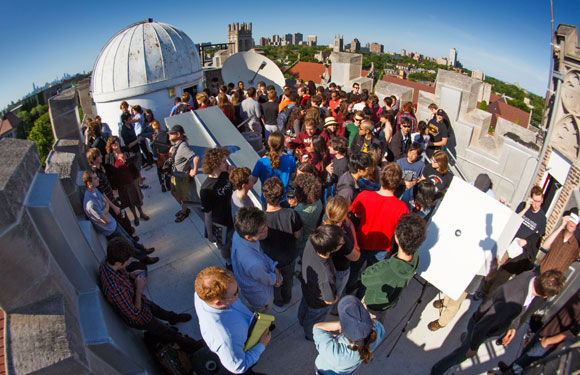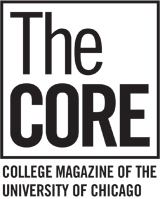
Eye on the Quads
RSO Spotlight: Ryerson Astronomical Society
During the transit of Venus, the RAS parties like it’s 2117.
By Benjamin Recchie, AB’03 | Photos by Jason Smith
When Venus traversed the sun this June for the last time until 2117, the Ryerson Astronomical Society (RAS) was on the case. Members set up viewing stations on the observatory deck atop Ryerson Physical Laboratory, helping about 150 amateur observers witness the rare celestial event. The origins of the RAS are lost in the mists of time, but it dates from at least the early 1950s. (The fact that the club’s 6.25-inch telescope was installed in the dome on Ryerson’s roof in 1937 suggests the organization could even be older.) We sat down with club president—or, in RAS parlance, “grand pooh-bob” [sic]—fourth-year Tad Komacek and vice president Alice Griffeth, AB’12, to find out what really goes on upon the roof of Ryerson late at night.
How big is your club?
TK: There are probably ten or 12 people who regularly come to meetings. And there are four or five people who come every once in a while.
AG: People come out of the woodwork for our big events—for our trip to Yerkes Observatory up in Wisconsin, for example. There are probably 300 names on the mailing list.
Your stated mission is “to encourage all humanity to behold the celestial luminaries in hushed awe.” How?
AG: We meet at the beginning of the quarter to talk about what the group wants to do. My first year in the club was very heavily focused on student talks, usually in a lecture series that had been voted on beforehand, like planetary geology. The lectures are supposed to be very laid-back and a chance to learn something you don’t know about.
We try to join a lot of interests together. We have quite a few people involved with the Engineering Society RSO, so we’ve had a lot more interest in hands-on stuff this year, like setting up the detector on our new radio telescope on the roof. For our trip to Yerkes last quarter, a big group of us biked there—including Tad—because we have several members who are also in the Outdoor Adventure Club.
We’ve gone to Adler Planetarium a few times. And we watch Carl Sagan’s [AB’54, SB’55, SM’56, PhD’60] Cosmos at the end of the quarter during finals week, because nobody wants to give a talk.
How many people come to Ryerson Wednesdays, when you open up your antique telescope for public observing?
TK: Depends on how nice it is. If it’s cold, three, including Alice and me. But during last finals week, when Jupiter, Venus. Mars, and Uranus were all visible, and the weather was nice, 50 people came. If the sky’s exciting, more people show up.
AG: A lot more people come in the spring. People don’t want to come in the winter, and we often have to cancel anyway because of weather.
A lot of observing is just our members who have keys and come up to the dome whenever they want. I’ve led house trips up here before. It’s always a pleasure to take friends up. My roommate, who’s a political science major and knows nothing about space, loves to come up here with me. It’s a hidden gem of the University.
Is it difficult to see things in Chicago’s light-polluted skies?
AG: If we want to do serious observing, looking at something really faint, we do that at Yerkes. But we can see the moon and the planets well here. We do have to cancel observing a lot because of clouds, weather, haze, things like that.
TK: We’re involved in anti–light pollution efforts. We still elect an officer for that, but at this point, it’s just really frustrating because nobody else seems to be taking it seriously.
RAS has a tradition of making ridiculous budget requests from the Student Government’s Annual Allocations Committee, like in 2007 when you requested three trillion rubles to build and launch a replica of Sputnik.
AG: We usually request some obscene amount of money, like billions of dollars. It never gets funded, of course.
TK: Yeah. I’ve got to do that next week. The past couple of years, our former president, Will Vaughan, SB’11, asked for money for a space elevator.
Are most of the club’s members majoring in the sciences?
AG: Most are in physics or geophysical sciences. Most of the rest are first- and second-years who haven’t declared a major.
TK: All these related clubs meet on Mondays: Society of Physics Students at 6:00, GeoUnion at 7:00, and RAS at 8:00 p.m. The other groups have money for food, so we save some money by not feeding people.
AG: Once we had a group of four sorority girls come to see one of their sisters who was giving a talk. They cheered and brought posters. It’s something I never thought I would see.
TK: They were the only ones who asked questions after that talk.
AG: It was such a stereotype breaker. I loved it.
Note: After the interview was conducted, the RAS asked Student Government for the astronomical sum of $14 million to build a spaceship to travel to and from the star Vega, as in Carl Sagan’s novel Contact. They were allocated $1,079.48.
